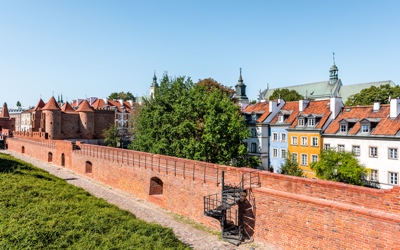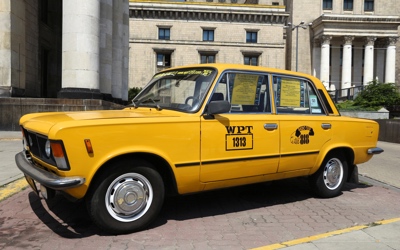
Private Tour: Warsaw in Nutshell Sightseeing by retro minibus
3 h
Yksityinen
Välitön vahvistus
Lisätietoja aktiviteetista
Itinerary
This is a typical itinerary for this product
Stop At: Grzybowski Square, Warsaw Poland
Probably the most eclectic square in Warsaw.
Duration: 20 minutes
Pass By: Rynek Starego Miasta, Warsaw Poland
The Old Town Market Place is the true heart of the Old Town, and until the end of the 18th century it was the heart of all of Warsaw. It originated in the late 13th century, at the same time that the city was founded. Here the representatives of guilds and merchants met in the town hall and fairs and the occasional execution were held. The houses around it represented the Gothic style until the great fire of 1607, after which they were rebuilt in late-Renaissance style and eventually in late-Baroque style.
Stop At: Archcathedral Basilica of St. John the Baptist, Swietojanska 8, Warsaw 00-278 Poland
St. John's Archcathedral is one of Poland's national pantheons and stands immediately adjacent to Warsaw's Jesuit church. Along with the Old Town, the church has been listed by UNESCO as of cultural significance.
Duration: 5 minutes
Pass By: Zamek Krolewski w Warszawie - Muzeum, Plac Zamkowy 4, Warsaw 00-277 Poland
The Royal Castle in Warsaw is a castle residency that formerly served throughout the centuries as the official residence of the Polish monarchs.
Burned and looted by the Nazi Germans following the Invasion of Poland in 1939 and almost completely destroyed in 1944 after the failed Warsaw Uprising, the Castle was completely rebuilt and reconstructed.
Pass By: King Sigismund's Column (Kolumna Zygmunta), Castle Square Old Town, Warsaw Poland
Sigismund's Column, originally erected in 1644, is located in Castle Square and is one of Warsaw's most famous landmarks. The column and statue commemorate King Sigismund III Vasa, who in 1596 had moved Poland's capital from Kraków to Warsaw.
Pass By: Mariensztat Square (Rynek Mariensztacki), Ul. Bednarska, Warsaw Poland
Mariensztat is one of the smallest districts of Warsaw. Currently, almost all the housing was built in 1948-1949. This was the first Warsaw housing estate built after World War II on a spot completely destroyed in the Warsaw Uprising. Much of the rebuild, built with bricks from demolition in Warsaw.
Pass By: Bazylika katedralna Sw. Michala Archaniola i Sw. Floriana Meczennika, ul. Florianska 3, Warsaw 00-001 Poland
The Cathedral of St. Michael the Archangel and St. Florian the Martyr is a Catholic church and historic landmark in eastern Warsaw. During and after the Siege of Warsaw, church was used as a hiding place for Jews, the Warsaw Army and as a general refuge for civilians.
Pass By: Warsaw's Metropolitan Cathedral of St. Mary Magdalene, ul. aleja Solidarnosci 52, Warsaw 03-402 Poland
Metropolitan Orthodox St. Mary Magdalene Church was opened in 1869. The building is inspired by Byzantine architecture. It is one of the biggest Polish Orthodox Churches.
Pass By: Praga Polnoc, ul.Zabkowska, Warsaw Poland
Praga is one of the oldest districts in Warsaw. Through the centuries, Warsaw's right-bank was an independent town. In 1648 it was granted municipal rights by the king Władysław IV Vasa. It was joined to Warsaw at the end of 18th century. In 1945 it was divided into Praga-North and Praga-South
Pass By: Zabkowska Street, Zabkowska, Warsaw Poland
Ząbkowska Street is one of the oldest streets in Warsaw.
Koneser district. After the war, Koneser was one of the largest producers of vodka - the main export product and its own currency in communist Poland.
Events, food, fashion, design, art and unique urban space. This is a new modern Koneser. The historic vodka factory in the heart of Old Praga returns to the map of the capital in an energetic, lifelike version.
Pass By: PGE National Stadium, ul. aleja Ksiecia Jozefa Poniatowskiego 1, Warsaw 03-901 Poland
Before 2008 on the PGE National Stadium place was the 10th-Anniversary Stadium, opened in 1955. The Stadium until dusk PRL served as the most representative sports facility in the country.
The Stadium was constructed mostly with rubble from buildings destroyed during the Warsaw Uprising of 1944.
In 1983, due to technical problems, the stadium was abandoned. In 1989 the stadium was turned into an outdoor market known as Jarmark Europa, which became Europe's largest open-air market.
Stop At: Plac Konstytucji, plac Konstytucji, Warsaw 00-001 Poland
The Constitution Square was constructed in the initial post-war years as a main element of social realist urban project. Together with the Palace of Culture and Science it was the main architectural social realist investment of Warsaw in 1949-1956. Its name comes from the Stalinist constitution adopted in communist Poland.
Duration: 15 minutes
Pass By: Palace of Culture and Science, Plac Defilad 1, Warsaw 00-110 Poland
The Palace of Culture and Science is the undisputed symbol of Warsaw. The Palace was built in 1952-1955 as a gift from the Soviet Union to the people of Poland.
Varsovians still commonly use nicknames to refer to the Palace, notably "Beijing", "clown", "nightmarish dream of a drunk confectioner", "Stalin's syringe", "small but stylish". Other less common names include "the Elephant in Lacy Underwear", "Russian wedding cake", or even "Stalin's dick".
The permanent residents of the Palace are cats that live in the basement. Animals have their guardian who cares about them. In the highest part of the Palace, peregrine falcons live, which just below the spire, have their nest erected. They have been there since 1998. A pair of falcons have young children there. In the Internet users' competition, the young falcons were given the names: Bazyl, Orion and Wawa. A little lower in towers at the height of the 15th floor, the kestrels found their asylum. And on the level of the 6th floor, on the roof of the Studio Theater, among the melliferous bushes, there is an apiary of urban bees.
Pass By: Palm Tree, Plac de Gaulle, Warsaw 00-001 Poland
A rumour circulates around Warsaw that the Palm Tree is a gift from the city of Jerusalem for Aleje Jerozolimskie in Warsaw, that in this way Israeli Jews wanted to show Christians Polish how a real Christmas tree looks like.
As the Polish expression ‘hit by a palm tree’ refers to something unthinkable, a behaviour that verges on being silly, even idiotic, the project thus embodies substantial humour and irony, which saves it from linear reading and suggests something that escapes palpable understanding.
Pass By: Old Town, Warsaw Poland
Get to know the history of Warsaw from its cradle to modern days.
The Old Town was established in the 13th century. Initially surrounded by an earthwork rampart, prior to 1339 it was fortified with brick city walls. The town originally grew up around the castle of the Dukes of Mazovia that later became the Royal Castle.
Surrounding streets feature medieval architecture such as the city walls, the Barbican and St. John's Cathedral.
Lue lisää
Näytä vähemmän
This is a typical itinerary for this product
Stop At: Grzybowski Square, Warsaw Poland
Probably the most eclectic square in Warsaw.
Duration: 20 minutes
Pass By: Rynek Starego Miasta, Warsaw Poland
The Old Town Market Place is the true heart of the Old Town, and until the end of the 18th century it was the heart of all of Warsaw. It originated in the late 13th century, at the same time that the city was founded. Here the representatives of guilds and merchants met in the town hall and fairs and the occasional execution were held. The houses around it represented the Gothic style until the great fire of 1607, after which they were rebuilt in late-Renaissance style and eventually in late-Baroque style.
Stop At: Archcathedral Basilica of St. John the Baptist, Swietojanska 8, Warsaw 00-278 Poland
St. John's Archcathedral is one of Poland's national pantheons and stands immediately adjacent to Warsaw's Jesuit church. Along with the Old Town, the church has been listed by UNESCO as of cultural significance.
Duration: 5 minutes
Pass By: Zamek Krolewski w Warszawie - Muzeum, Plac Zamkowy 4, Warsaw 00-277 Poland
The Royal Castle in Warsaw is a castle residency that formerly served throughout the centuries as the official residence of the Polish monarchs.
Burned and looted by the Nazi Germans following the Invasion of Poland in 1939 and almost completely destroyed in 1944 after the failed Warsaw Uprising, the Castle was completely rebuilt and reconstructed.
Pass By: King Sigismund's Column (Kolumna Zygmunta), Castle Square Old Town, Warsaw Poland
Sigismund's Column, originally erected in 1644, is located in Castle Square and is one of Warsaw's most famous landmarks. The column and statue commemorate King Sigismund III Vasa, who in 1596 had moved Poland's capital from Kraków to Warsaw.
Pass By: Mariensztat Square (Rynek Mariensztacki), Ul. Bednarska, Warsaw Poland
Mariensztat is one of the smallest districts of Warsaw. Currently, almost all the housing was built in 1948-1949. This was the first Warsaw housing estate built after World War II on a spot completely destroyed in the Warsaw Uprising. Much of the rebuild, built with bricks from demolition in Warsaw.
Pass By: Bazylika katedralna Sw. Michala Archaniola i Sw. Floriana Meczennika, ul. Florianska 3, Warsaw 00-001 Poland
The Cathedral of St. Michael the Archangel and St. Florian the Martyr is a Catholic church and historic landmark in eastern Warsaw. During and after the Siege of Warsaw, church was used as a hiding place for Jews, the Warsaw Army and as a general refuge for civilians.
Pass By: Warsaw's Metropolitan Cathedral of St. Mary Magdalene, ul. aleja Solidarnosci 52, Warsaw 03-402 Poland
Metropolitan Orthodox St. Mary Magdalene Church was opened in 1869. The building is inspired by Byzantine architecture. It is one of the biggest Polish Orthodox Churches.
Pass By: Praga Polnoc, ul.Zabkowska, Warsaw Poland
Praga is one of the oldest districts in Warsaw. Through the centuries, Warsaw's right-bank was an independent town. In 1648 it was granted municipal rights by the king Władysław IV Vasa. It was joined to Warsaw at the end of 18th century. In 1945 it was divided into Praga-North and Praga-South
Pass By: Zabkowska Street, Zabkowska, Warsaw Poland
Ząbkowska Street is one of the oldest streets in Warsaw.
Koneser district. After the war, Koneser was one of the largest producers of vodka - the main export product and its own currency in communist Poland.
Events, food, fashion, design, art and unique urban space. This is a new modern Koneser. The historic vodka factory in the heart of Old Praga returns to the map of the capital in an energetic, lifelike version.
Pass By: PGE National Stadium, ul. aleja Ksiecia Jozefa Poniatowskiego 1, Warsaw 03-901 Poland
Before 2008 on the PGE National Stadium place was the 10th-Anniversary Stadium, opened in 1955. The Stadium until dusk PRL served as the most representative sports facility in the country.
The Stadium was constructed mostly with rubble from buildings destroyed during the Warsaw Uprising of 1944.
In 1983, due to technical problems, the stadium was abandoned. In 1989 the stadium was turned into an outdoor market known as Jarmark Europa, which became Europe's largest open-air market.
Stop At: Plac Konstytucji, plac Konstytucji, Warsaw 00-001 Poland
The Constitution Square was constructed in the initial post-war years as a main element of social realist urban project. Together with the Palace of Culture and Science it was the main architectural social realist investment of Warsaw in 1949-1956. Its name comes from the Stalinist constitution adopted in communist Poland.
Duration: 15 minutes
Pass By: Palace of Culture and Science, Plac Defilad 1, Warsaw 00-110 Poland
The Palace of Culture and Science is the undisputed symbol of Warsaw. The Palace was built in 1952-1955 as a gift from the Soviet Union to the people of Poland.
Varsovians still commonly use nicknames to refer to the Palace, notably "Beijing", "clown", "nightmarish dream of a drunk confectioner", "Stalin's syringe", "small but stylish". Other less common names include "the Elephant in Lacy Underwear", "Russian wedding cake", or even "Stalin's dick".
The permanent residents of the Palace are cats that live in the basement. Animals have their guardian who cares about them. In the highest part of the Palace, peregrine falcons live, which just below the spire, have their nest erected. They have been there since 1998. A pair of falcons have young children there. In the Internet users' competition, the young falcons were given the names: Bazyl, Orion and Wawa. A little lower in towers at the height of the 15th floor, the kestrels found their asylum. And on the level of the 6th floor, on the roof of the Studio Theater, among the melliferous bushes, there is an apiary of urban bees.
Pass By: Palm Tree, Plac de Gaulle, Warsaw 00-001 Poland
A rumour circulates around Warsaw that the Palm Tree is a gift from the city of Jerusalem for Aleje Jerozolimskie in Warsaw, that in this way Israeli Jews wanted to show Christians Polish how a real Christmas tree looks like.
As the Polish expression ‘hit by a palm tree’ refers to something unthinkable, a behaviour that verges on being silly, even idiotic, the project thus embodies substantial humour and irony, which saves it from linear reading and suggests something that escapes palpable understanding.
Pass By: Old Town, Warsaw Poland
Get to know the history of Warsaw from its cradle to modern days.
The Old Town was established in the 13th century. Initially surrounded by an earthwork rampart, prior to 1339 it was fortified with brick city walls. The town originally grew up around the castle of the Dukes of Mazovia that later became the Royal Castle.
Surrounding streets feature medieval architecture such as the city walls, the Barbican and St. John's Cathedral.
Sisältyy
- Parking Fees
- Professional local guide
- Transport by retro communist minibus
Lisäksi
- Confirmation will be received at time of booking
- Not wheelchair accessible
- Near public transportation
- Not recommended for travelers with back problems
- No heart problems or other serious medical conditions
- Cars are used mainly for transfers between locations where guests have walks with their guide.
- If two minibuses are used on the tour guide will ride in only one during transfers (the second guide is extra paid).
- Tours with retro minibuses are available only for persons taller than 150 cm (4,9 ft).
- Youth under 18 years old must be accompanied by an adult.
- Retro minibuses are not equipped with air conditioning, they are equipped with an efficient heating system for wintertime.
- Some of the retro minibuses are not equipped with seatbelts (which is legal with classic vintage cars).
- Cancellation fee of 100% is charged if cancelled 2 day(s) or less before the tour.
- Most travelers can participate
- This is a private tour/activity. Only your group will participate
Ominaisuudet
Turismi
90%
Kulttuuri
75%
Valikoimat
Tämä kokemus kuuluu seuraaviin valikoimiin
Saatat pitää myös









 Näytä kaikki 24 Valikoimat
Näytä kaikki 24 Valikoimat
Napsauta tutustuaksesi muihin kokemuksiin
Näytä kaikki
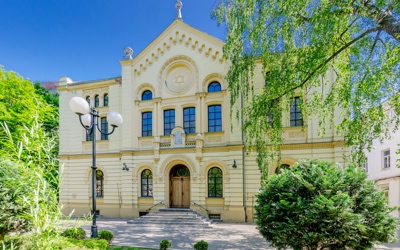
Valikoimat
Jewish Heritage
21 Aktiviteetit
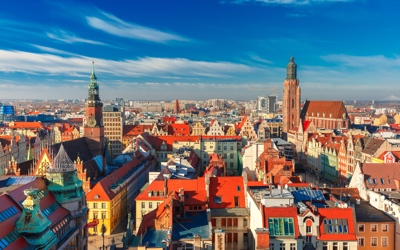
Valikoimat
Other Trip
36 Aktiviteetit

Valikoimat
Concentration Camp
16 Aktiviteetit
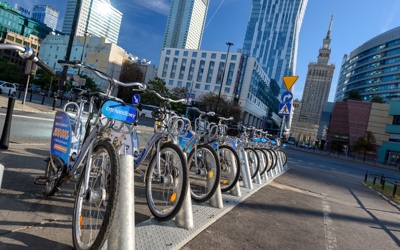
Valikoimat
Bike tour
3 Aktiviteetit
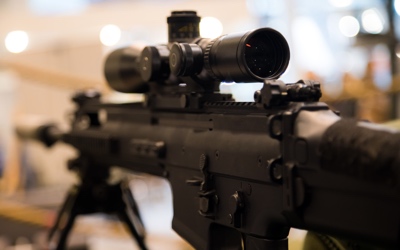
Valikoimat
Shooting Course
5 Aktiviteetit

Valikoimat
Night Life
14 Aktiviteetit
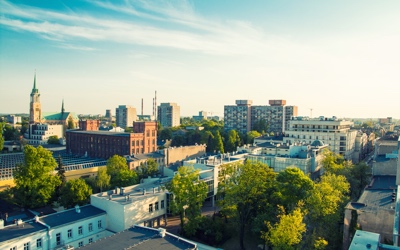
Valikoimat
Lodz
4 Aktiviteetit

Valikoimat
Segway
9 Aktiviteetit
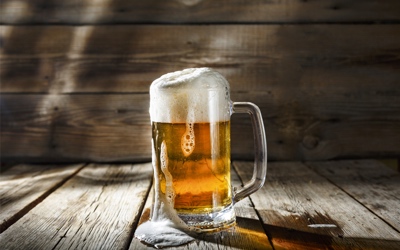
Valikoimat
Polish beer
7 Aktiviteetit

Valikoimat
Vodka
10 Aktiviteetit


